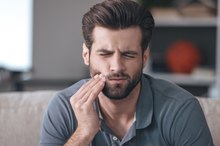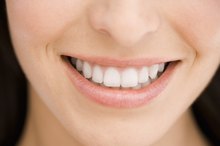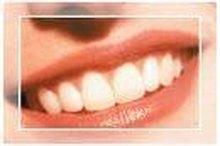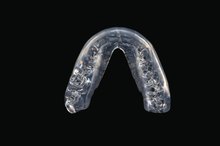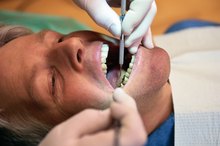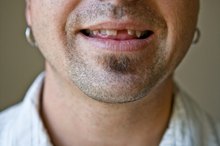Side Effects of Dental Veneers
Dental veneers consist of thin, customized, tooth-colored coverings that qualified dentists bond to the outer surface of teeth. Dental veneers can correct problems related to the color, length, size and shape of teeth when properly constructed and attached. Like any medical or dental procedure, sometimes problems occur, often due to characteristics of the veneer, your teeth and your dentist's decisions during the procedure.
Color Irregularities
The final color of a dental veneer depends on various factors. The shade of the veneer, the color of the underlying tooth and the color of the bonding substance all determine what the dental veneer will look like once the dentist attaches it. If your dentist does not give those three contributing factors adequate consideration, placed veneers may not match the color of surrounding teeth. Some dental veneers may develop discoloration or stains along the edges due to issues like the presence of moisture when the dentist seals the veneers. Unfortunately, dentists cannot alter or correct the color of dental veneers after they attach them.
- The final color of a dental veneer depends on various factors.
- Some dental veneers may develop discoloration or stains along the edges due to issues like the presence of moisture when the dentist seals the veneers.
Placement Issues
What Is the Difference Between Dental Bonding & Veneers?
Learn More
When dentists do not position dental veneers properly, your teeth can develop such problems as chipping and decay outside the edges of the veneers. Other placement-related issues include overhanging or rough-edged veneers, which can cause dental floss to catch on the edges, making recommended oral hygiene difficult and gum irritation possible. Lining up the margins of veneers with the chewing edge of teeth too precisely can also cause the veneers to chip beyond repair, whereas removing too little of the outer surface of the teeth may cause placed veneers to look bulky or thick.
Sensitive Teeth
Placing dental veneers on teeth requires dentists to remove an adequate amount of enamel from the surface of teeth. Consequently, teeth may become sensitive after the procedure, leading to discomfort when you place cold or hot items in your mouth. If your dentist removes too much of the outer tooth, the pulp on the inside of the tooth may eventually die. If a dentist must remove substantial portions of the tooth to place a dental veneer, you might ask about getting a crown for the tooth instead to avoid these problems.
- Placing dental veneers on teeth requires dentists to remove an adequate amount of enamel from the surface of teeth.
- If a dentist must remove substantial portions of the tooth to place a dental veneer, you might ask about getting a crown for the tooth instead to avoid these problems.
Veneer Damage
A Toothache in the Tooth With a Crown
Learn More
Certain people are not good candidates for dental veneers because of their oral habits. For instance, the Cleveland Clinic notes that individuals who clench or grind their teeth can eventually weaken and damage dental veneers made of porcelain, leading to chips or cracks 3. Veneers can also experience damage if you bite down on or chew a hard item, such as ice, pencils or even your fingernails. Such behavior can place too much pressure on dental veneers, causing them to loosen or fall off altogether.
- Certain people are not good candidates for dental veneers because of their oral habits.
- Such behavior can place too much pressure on dental veneers, causing them to loosen or fall off altogether.
Related Articles
References
- "The Journal of the American Dental Association"; Facing the Challenges of Ceramic Veneers; Gordon J. Christensen; May 2006
- Cleveland Clinic: Veneers
- Chu CH, Zhang CF, et al. Treating a maxillary midline diastema in adult patients, A general dentist’s perspective. American Dental Association JADA. 2011;142(11)1258-1264.
- Hussaina U, Ali Ayubb A, Farhanc M. Etiology and treatment of midline diastema: A review of literature. POJ. 2013:5(1) 27-33.
- Nagalakshmi S, Sathish R, Priya K, Dhayanithi D. Changes in quality of life during orthodontic correction of midline diastema. J Pharm Bioallied Sci. 2014;6(Suppl 1):S162-4. doi:10.4103/0975-7406.137435
- Dentaly.org. Diastema: Closing gaps in teeth with braces, veneers and other options. Updated June 22, 2019.
- Appleby J, Knight V. Kaiser Health News. In-home teeth-straightening business is booming ― but better brace yourself. Updated January 23, 2020.
- Oquendo A, Brea L, David S. Diastema: correction of excessive spaces in the esthetic zone. Dent Clin North Am. 2011;55(2):265-81, viii. doi:10.1016/j.cden.2011.02.002
Writer Bio
Nathania Maddox began editing and writing professionally in 2001. She has contributed articles to several online publications, covering topics ranging from health to law. Maddox holds a Bachelor of Arts and Master of Arts in linguistics.

